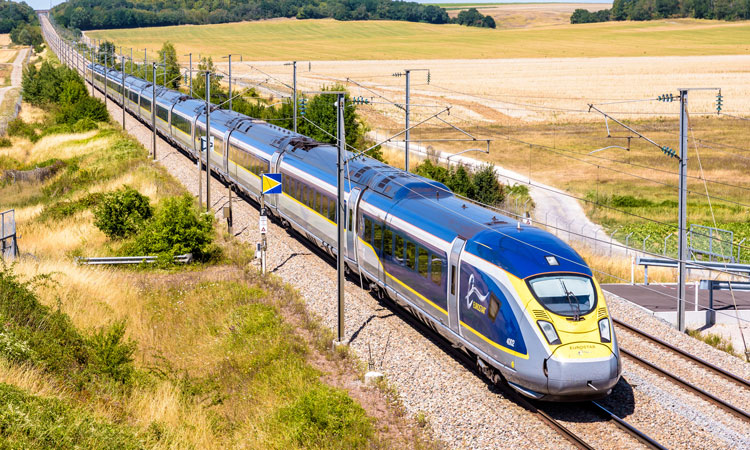HS1’s environmental and sustainability commitments
Posted: 19 February 2021 | Dyan Crowther, Richard Thorp | No comments yet
HS1 Ltd’s Dyan Crowther, CEO, and Richard Thorp, Engineering Director, write that sustainability is key to getting the rail industry back on track – and there is a lot to learn from the UK’s only high‑speed railway.


High-speed rail plays a crucial role in connecting communities and businesses and driving economies, not just locally, but internationally, too. As the Green Gateway to Europe, the HS1 line already provides significant sustainable and environmental benefits to the regions it serves and across Europe. However, its recent efforts to lead the way on the green transport agenda are already creating lasting solutions to sustainable travel. With a post-COVID-19 recovery around the corner, the international rail industry can certainly learn some lessons from the UK’s only high-speed railway.
The rail sector has faced a fair set of challenges and changes over the years, but, this past year, it has experienced what is undoubtedly the biggest shock in living memory. Changing quarantine rules, lockdowns and varying travel restrictions have had a profound impact on businesses and operators. Whilst this looks set to continue in the first few months of 2021, there is light at the end of the tunnel as the roll out of the UK government’s vaccination programme accelerates day by day. Another focus will clearly be the huge set of commitments to become a net zero economy by 2050 – a goal which has been enshrined into UK law. As Glasgow hosts the upcoming global conference, COP26 (where HS1 Ltd is proud to have been invited to participate on a panel and host a workshop), it is more important than ever that sustainable travel is at the forefront of the political agenda. The UK must set an example of how it is leading the charge in delivering green initiatives in this space.
The post-pandemic recovery will not happen on its own, and it is critical that businesses in the rail industry begin to have long-term sustainability measures at the very centre of their strategy. High-speed train travel already offers a more environmentally friendly alternative to cars and planes, providing a swathe of environmental benefits to the UK and beyond. Independent research shows that international high-speed rail saves the equivalent CO2 emissions of 60,000 flights per year, with a total of £7 million in environmental costs recouped from people choosing to take the train rather than fly. Domestic services on the UK line remove 6,000 lorries and cars from the roads over the same timeframe, bringing 400,000 people within an hour’s commute of London, and has already encouraged the construction of 15,000 affordable homes.
Whilst the benefits of high-speed are already significant, we have not stopped there. In October 2020, we published our plan to become the UK’s first fully carbon neutral railway. This commitment fits into our wider Sustainability Strategy, which includes a roadmap to make our railway even more sustainable and to build on our position as the Green Gateway to Europe.
Working with several partners, we have been able to set out stringent new environmental targets across the entire network that we will meet, at the very latest, by 2030 – way ahead of the UK government’s 2050 goal. This includes six key priority areas, ranging from climate impacts to biodiversity. By delivering improvements to the rail industry and promoting best practice, we hope to provide our passengers with opportunities to make better environmental choices and enjoy more sustainable travel. We want to be a role model for the rest of the industry and beyond, including HS2, as construction of Europe’s biggest infrastructure project runs on apace. Our priority areas are:
Climate change
It is clear that making the right transport choice has a huge role to play in global carbon emissions, and high-speed rail offers low-emission transport for the future. Train travel is already 80-90 per cent more carbon friendly than air travel, but we are still looking at ways to continue to reduce our impacts on climate change.
Our targets include traction energy to be net zero-carbon impact by 2030 (traction energy relates to the energy used to power the trains); and HS1’s wider energy use to be net zero-carbon impact by 2030 (relating to all other energy, such as to power our buildings).
Energy use
Energy is a precious resource, so we are seeking to minimise our energy use wherever possible. In parallel, we are working to secure sustainable and renewable energy sources for our transport, estates and vehicles.
Our targets include reducing traction per passenger journey by 25 per cent by 2030; reducing traction energy per train journey by 10 per cent by 2030; reducing non‑traction energy drawn from the grid by 10 per cent by 2030; and reducing non-traction energy consumption per square foot in our estates by 10 per cent by 2030.
Resource use and waste
We recognise our role in using products and materials more efficiently and ensuring that they are recovered when we no longer need them. HS1 Ltd commissions major construction, refurbishment and track maintenance projects that create waste. To reduce our waste and be more responsible, we have set out targets to be met by 2022 and 2023.
Our targets include ensuring that zero non‑hazardous waste is sent to landfill from regular operations and projects by 2022, and 90 per cent recycling of operations and project wastes by 2023.
Social impacts
Our role in the community is important to us as a responsible neighbour and as an inspiration for everyone that uses our services and facilities. We aim to demonstrate our leadership in providing a positive contribution to the communities in and around our stations and lineside. We also place a high value in contributing our time and expertise to enabling those communities to flourish.
Our targets include contributing 700 hours of staff time each year to local communities and charity activities related to HS1’s activities by the end of 2022, and ensuring measurable social impacts are delivered by the end of 2025.
Biodiversity
We manage a diverse estate, from Central London to the Garden of England (Kent). We are committed to maintaining a healthy and diverse natural environment. Under the requirement of the Channel Tunnel Rail Act 1996, we have an obligation to protect and enhance the lineside habitat.
Our target for 2030 is to deliver a ‘Biodiversity Net Gain’ (BNG) based on the 2020 baseline pending the completion of the full survey in 2021, which will confirm if BNG2030 is achievable and, if not, what we are able to achieve by 2030.
Transparency
We will report the progress of our strategy to our investors, partners and stakeholders to demonstrate how we are progressing towards achieving our targets. To do this, we will establish an appropriate ESG reporting scheme and framework. This will maintain compliance with all environmental regulatory requirements (and any initiatives that we sign up to) and report against these in our annual reporting.
The high-speed rail sector needs government support for these environmental benefits to continue
We recognise and support the measures taken by the UK government to mitigate the impact on the sector caused by the outbreak of COVID-19. However, the reduction in the number of services has had a significant impact on the rail sector and our ability to continue offering the most sustainable mode of transport. Many other sectors have suffered a great deal due to restrictions on international travel, and the aviation sector has experienced a similar outcome. However, the overwhelming difference is that the aviation sector has received various support packages from the government to keep it afloat, whilst international high-speed rail has received no direct funding.
We are working hard with our partners to try to ensure that the UK government does not allow international train travel to be put at a competitive disadvantage to flying – especially as it is far more environmentally friendly. Currently, the high-speed system is extremely vulnerable, and Eurostar, our international operator, is not able to run the level of service it usually would and are operating a significantly reduced timetable. Specifically, Eurostar has stopped services to Ebbsfleet International Station and Ashford International Station, and does not plan to reintroduce these vital services until 2022. This means that customer choice is being undermined and the important economic and environmental benefits that it delivers are at risk.
It is becoming increasingly clear that our Green Gateway to Europe is in need of support so that it can deliver in full on its green potential. As an essential piece of infrastructure to the nation’s future growth, HS1 provides connectivity in the most efficient and environmentally friendly way. This is most certainly a model that current and future rail organisations can learn from.




Issue
Related topics
Coronavirus/COVID-19, High-Speed Rail, Sustainability/Decarbonisation








